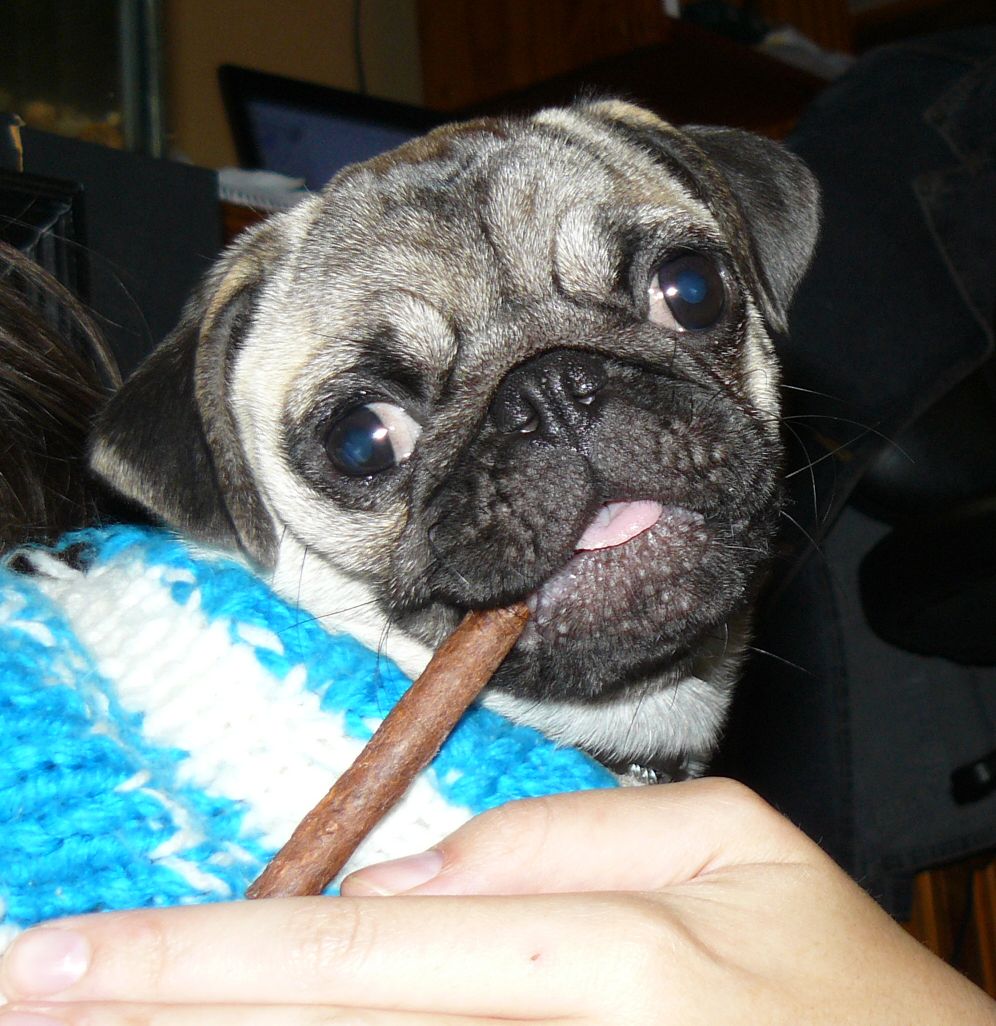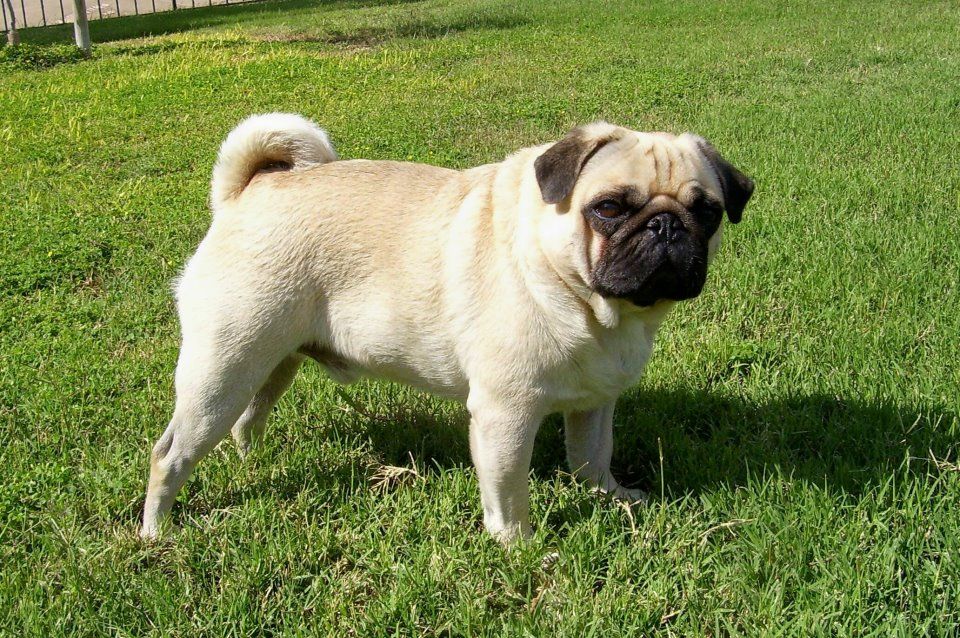There's no denying it,
pugs are cute. Those little wrinkles on their faces and the curly
tails … it's enough to make most anyone go 'aw'. Add to this
cuteness a propensity for begging and a bottomless pit for a tummy,
plus a tendency to prefer a warm lap over an intense workout … it's
no wonder so many pugs are overweight. I mean, who can resist this
face?
 |
| Talos is such a charmer! |
Why is too much weight
a problem?
Being overweight comes at
a hefty price, though (pardon the pun!). Medically, being overweight
increases breathing difficulty, something no pug needs. It increases
the risk of cardiovascular complications like heart attacks and
strokes, and it makes dogs more susceptible to diabetes. Being heavy
places extra strain on a dog's joints, and makes an already
heat-intolerant pug even more so. There is an increased risk of
cancer. The liver can't function as well either.
Practically, being
overweight makes any surgical procedures more risky. It can make it
difficult or impossible to hear a dog's heartbeat, or to find a vein
to administer anaesthetics. It also makes for a larger, much more
cumbersome pet to transport. Pugs are cuddle-buddies, but too big a
cuddle buddy can't easily sit on a lap any more.
The most prominent reason
for me personally to help your furry friend weight less, though, is
the impact being overweight has on their quality and length of life.
They are more lethargic, and less eager to play and to go places with
you.
 |
| Loopythepug's Loopy is clearly happy to be out and about |
How do I know if my
pug is overweight?
Now
that I've got everyone convinced that slim-and-trim is the way to go,
we need to know how to judge if a dog is overweight. There are many
given methods to judge, but for me, a combination of three things
seems to work best. Firstly, with pure bred dogs like pugs, you have
a slight advantage. You have some idea of what a typical pug should
weigh – between 6 and 9 kilograms (14 to 20 lbs) according to the
AKC standard. This is a poor guide for many pugs, though – they
seem especially variable in size, with even champion litters
occasionally having very small or very large pugs.
Secondly,
you can judge weight by feeling for certain features. The key area
here is the ribs. Believe it or not, you actually want to be able to
feel each rib fairly easily under that lovely coat of fur. If you run
your fingers along the back of your hand, you can get a good idea of
what it should feel like – each bone is distinguishable without
being overly prominent. If each rib bone is very distinct, and you
can easily feel the hip bones (to either side of the tail when it's
curled up over their back), chances are your pug is a little too
skinny.
 |
| Wonka and Nilla's Wonka shows off a lovely waistline on the beach. |
Finally,
you can tell by looking at your pug. I think this is where pugs make
life difficult for us. Cobby and square, after all, does not look
like a greyhound (nor should it!). However, even on a beautifully
cobby pug, a waistline is apparent, and there is a slight tuck under
the tummy. Square from above is definitely not ideal.
 |
| Countrypug's Toby is a tank of a pug, square and cobby. No saggy stomach or bulgy belly here! |
How do I help my pug
lose weight?
As
pet owners, especially as owners of pugs, who typically do not hunt,
we have the great advantage of being able to control pretty much
everything our dog eats. This means that we can easily (no, little
pug, stop staring at me like that!) regulate our dog's daily intake
of food. The first thing to do, however, is to go see your vet.
Sometimes, weight problems are caused by thyroid issues, and it's
always best to have your vet on board with a weight loss program.
Every
weight loss program starts the same way – weigh that pooch.
Keeping a chart will really help keep track of things. There are many
weight loss diets available on the market, and your vet may prescribe
one of these to help your dog lose weight. While I am sure these food
have helped many, they promote weight loss by reducing fat and
protein, and increasing carbohydrates in many cases. This can
encourage excess glucose in the system, which is not always an ideal
situation (especially in a dog more prone to diabetes). Cautiously, I
would advise you to cut out a third of your dog's daily food ration
(this includes treats and table scraps if you feel you must give them
– everything shrinks by a third). Keep it up for two weeks, and
weigh your dog again. If your dog is losing weight, fantastic! Keep
it up until you get to an ideal weight. If there has been no weight
loss, decrease by another third, and repeat the experiment.
Since
a lot of overweight dogs have lower metabolisms, getting them moving
will really help speed along their weight loss. Walks, playing fetch
or tug, a doggy play date with a playful canine pal, even a dog sport
like obedience or canine freestyle will really help to get your pug
moving.
Remember
to get agreement and cooperation from the whole family. It won't help
if you're carefully counting calories while your significant other is
sneaking them cookies. In the end, this irresistible face is not
asking you for food, it's simply saying: “love me”.
 |
| Frida's pug Popeye |
source:
Wolfsheimer, KJ. Obesity in dogs. The Compendium on Continuing Education for the Practicing Veterinarian. 1994:981-998.
Wolfsheimer, KJ. Obesity in dogs. The Compendium on Continuing Education for the Practicing Veterinarian. 1994:981-998.
With thanks to the
members of Pug Village!
http://www.pugvillage.com
No comments:
Post a Comment